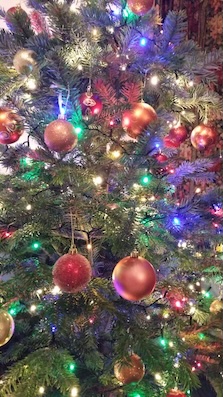 Cleanzine: your weekly cleaning and hygiene industry newsletter 26th June 2025 Issue no. 1168
Cleanzine: your weekly cleaning and hygiene industry newsletter 26th June 2025 Issue no. 1168
Your industry news - first
The original and best - for over 20 years!
We strongly recommend viewing Cleanzine full size in your web browser. Click our masthead above to visit our website version.
Christmas decorations found to harbour high levels of biological matter
 Whilst many of us may consider putting up the Christmas decorations as a festive and joyful time, new research suggests that it could also be responsible for helping to spread seasonal illnesses.
Whilst many of us may consider putting up the Christmas decorations as a festive and joyful time, new research suggests that it could also be responsible for helping to spread seasonal illnesses.
This research, based on real-world swabbing tests, found that the decorations that many of us bring back out every year could exceed what hygiene experts consider to be within the normal** range of biological contamination by 30%.
The swab tests were conducted using ATP* swabs and an ATP bioluminescence reader to detect levels of biological life not visible to the human eye. The tests were conducted on common festive decorations including Christmas trees, baubles, Christmas wreaths and Christmas tree lights.
The swabbing analysis found that over two thirds (68%) of the decorations tested gave a reading of over 500 units** - indicating a high level of contamination - and some even displayed readings of over 1,000 units. Those with the highest readings were harbouring five times more microbial contamination than an average toilet seat**.
Of all the items swabbed, artificial Christmas tree boxes displayed the highest readings (845 units average).
Christmas decorations (average counts recorded):
1. Christmas tree box (Ave reading: 845)
2. Christmas tree (Ave reading: 780)
3. Baubles (Ave reading: 610)
4. Christmas wreath (Ave reading: 430)
5. Christmas tree lights (Ave reading: 286)
***The ATP reading scale of objects used by our hygiene experts:
> 500 units (indicates a high level of biological contamination)
= 200-500 units (is considered to be within a normal range)
< 200 units (indicates a low level of biological contamination)
"Putting up decorations is a great way to get into the festive mood and kick off the Christmas season,” admits Jamie Woodhall, UK technical & innovations manager at Initial Washroom Hygiene. “And, with many of us enjoying this festive tradition with a mince pie or drink in hand and decorations often being passed from one person to another, as they are unpacked and hung up, then a cross contamination risk is naturally present.
"With 80% of all infections transmitted through hands, this can lead to the passing on of illness. No one wants their Christmas celebrations ruined by a seasonal bug, so it's advisable to take the proper precautions such as wiping down decorations with an antibacterial cloth and for everyone to wash and dry their hands before joining the decorating fun!"
Initial Washroom Hygiene's recommendations for a hygienic festive season:
* Wash hands frequently with soap and water, and then dry them properly with a warm air dryer or paper towel, especially after touching shared surfaces
* Use hand sanitiser when washing facilities aren't available.
* Avoid touching your face, particularly your mouth, nose, and eyes, after coming into contact with public touchpoints.
* Cover your mouth when coughing to help reduce the transmission of seasonal illnesses.
* ATP (adenosine triphosphate) is a molecule found in and around living cells.
About The Research:
**Detailed surface samples were taken from 25 Christmas Decorations in five homes in December 2024.
Toilet seat samples taken in 2012 from Initial Washroom Hygiene swabbing study, recorded an average of 220 units.
Samples were taken using sterile surface swabs and a rapid ATP analysis was undertaken on each sample to establish the level of microbial-related contamination on the surface of the items. The units are expressed as Relative Light Units by this method, with a higher ATP reading suggesting a greater level of bacterial contamination. This technique is widely used to assess the cleanliness of surfaces before and after undertaking cleaning in hospitals and other premises.
Initial Washroom Hygiene is a global leader in hygiene services operating in over 45 countries across the world including the major economies of Europe, North America, Asia Pacific and Africa. It provides innovative and environmentally responsible washroom services solutions to large and small organisations across a range of business sectors including public administrations and schools, food and drink manufacturing, hospitality and leisure, medical and paramedical, construction, retail, services and transportation.
The range of Initial Washroom Hygiene's services and supplies includes:
* Handwashing and drying products and services
* Feminine hygiene disposal units and services
* Products for washroom, urinal and toilet hygiene and cleaning
19th December 2024







